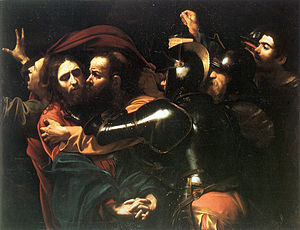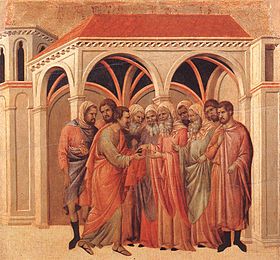Betrayal and Taking of Christ
The Taking of Christ by Caravaggio, ca. 1602.
According to the Canonical Gospels, after the Last Supper, Jesus and his disciples travel to Gethsemane, a garden located at the edge of the Kidron Valley, thought by scholars to probably have been an olive grove. Once there he is described as leaving the group so that he can pray privately.
The synoptics state that Jesus asked God that his burden be taken from him, and requesting not to need to undergo the events that he was due to, though giving the final choice to God. Luke states that an angel appeared and strengthened Jesus, who then returned to his disciples. The synoptics state that the three disciples that were with Jesus had fallen asleep, and that Jesus criticized them for failing to stay awake even for an hour, suggesting that they pray so that they can avoid temptation.
At this point Judas appears on the scene, accompanied by a crowd that includes the Jewish priests and elders and people with weapons. When the band of men enters the garden in search of Jesus, he steps forth and asks them, “Whom seek ye?”. They answer that they were indeed seeking Jesus of Nazareth. Jesus replied and spoke, “I am He”, at which point all members of the arrest party fall back and on the ground.
At this point Judas gives Jesus a kiss, as a pre-arranged sign to those that had accompanied Judas as to who Jesus was. Having been identified, the crowd arrests Jesus, although one of Jesus’ disciples tries to stop them by using a sword to cut off the ear of one of the men in the crowd.[2][3]
The Gospel of John specifies that it had been Simon Peter who had cut off the ear of Malchus, a servant of Caiaphas, the high priest.[2][3] Luke adds that Jesus healed the wound. John, Matthew, and Luke state that Jesus criticized the violent act, insisting that they do not resist Jesus’ arrest. In Matthew, Jesus makes the well known statement: all who live by the sword, shall die by the sword.
Judas making a bargain with the priests, depicted by Duccio, early 14th century.


He who cannot bear doubt does not bear himself.
The Incredulity of Saint Thomas by Caravaggio
You can never deny your knowledge of good and evil to yourself so that you could betray your good in order to live evil. For as soon as you separate good and evil, you recognize them. They are united only in growth. But you grow if you stand still in the greatest doubt, and therefore steadfastness in great doubt is a veritable flower of life.
He who cannot bear doubt does not bear himself. Such a one is doubtful; he does not grow and hence he does not live. Doubt is the sign of the strongest and the weakest. The strong have doubt, but doubt has the weak. Therefore the weakest is close to the strongest, and if he can say to his doubt: “I have you,” then he is the strongest. But no one can say yes to his doubt, unless he endures wide-open chaos. Because there are so many among us who can talk about anything, pay heed to what they live. What someone says can be very much or very little. Thus examine his life. ~Carl Jung, Red Book, Page 301.



